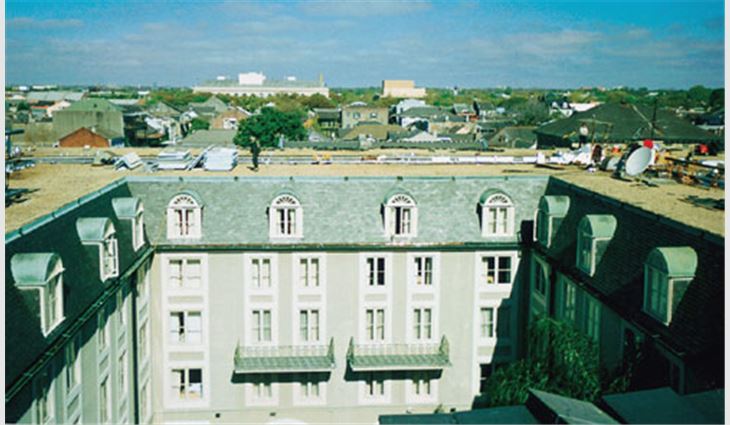 Photo courtesy of Roof Technologies Inc., Harvey, La.
Photo courtesy of Roof Technologies Inc., Harvey, La.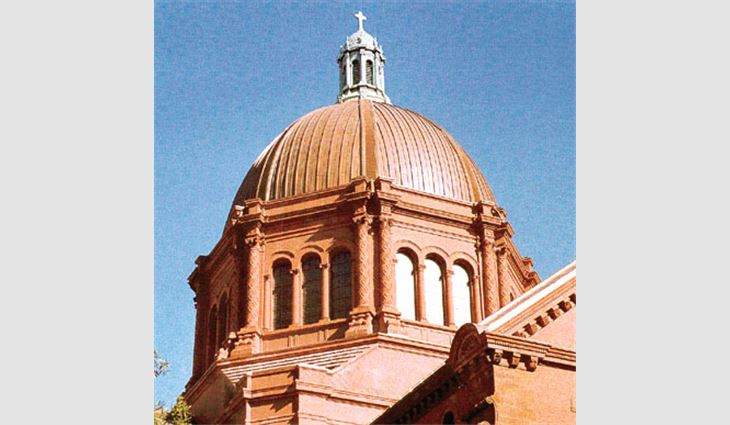 Photo courtesy of James Myers Co. Inc., Beltsville, Md.
Photo courtesy of James Myers Co. Inc., Beltsville, Md.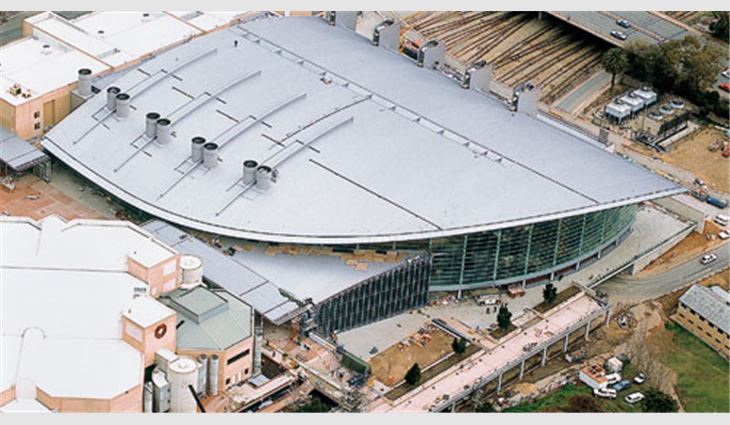 Photo courtesy of Chadwick Technology Property Ltd., Forestville, New South Wales, Australia.
Photo courtesy of Chadwick Technology Property Ltd., Forestville, New South Wales, Australia.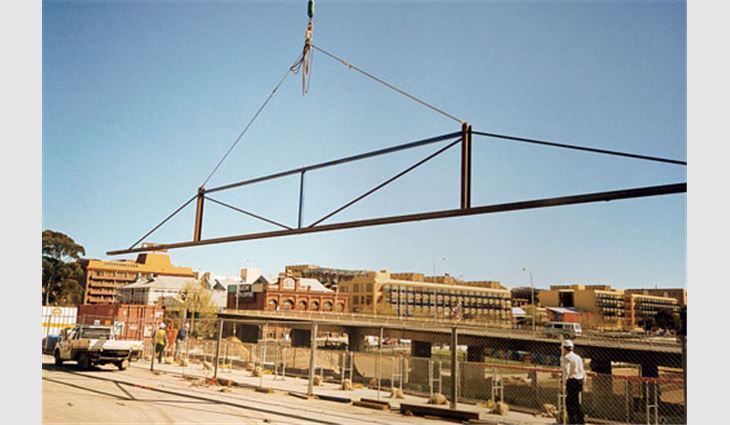 Photo courtesy of Chadwick Technology Property Ltd., Forestville, New South Wales, Australia.
Photo courtesy of Chadwick Technology Property Ltd., Forestville, New South Wales, Australia.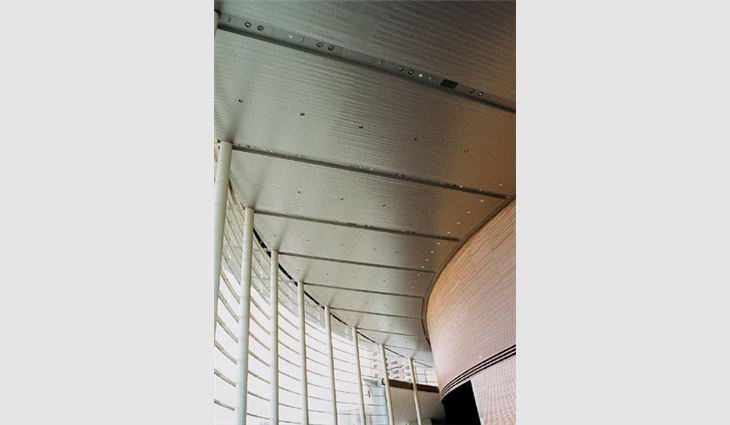 Photo courtesy of Chadwick Technology Property Ltd., Forestville, New South Wales, Australia.
Photo courtesy of Chadwick Technology Property Ltd., Forestville, New South Wales, Australia.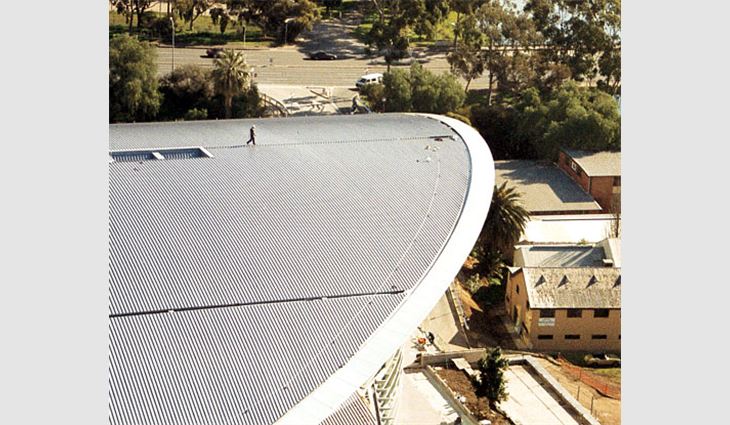 Photo courtesy of Chadwick Technology Property Ltd., Forestville, New South Wales, Australia.
Photo courtesy of Chadwick Technology Property Ltd., Forestville, New South Wales, Australia.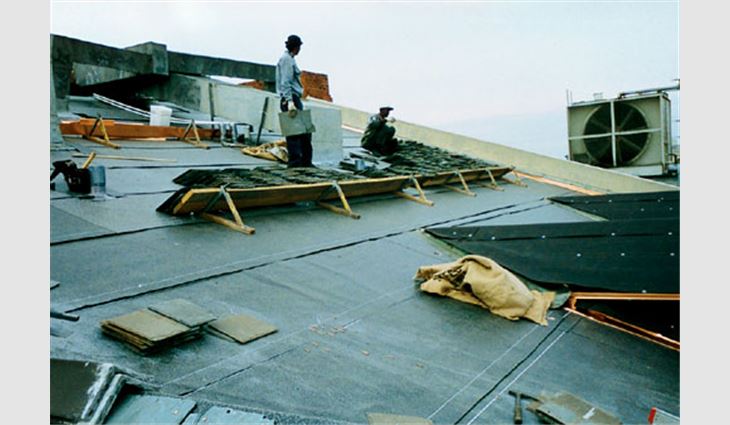 Photo courtesy of Roof Technologies Inc., Harvey, La.
Photo courtesy of Roof Technologies Inc., Harvey, La. 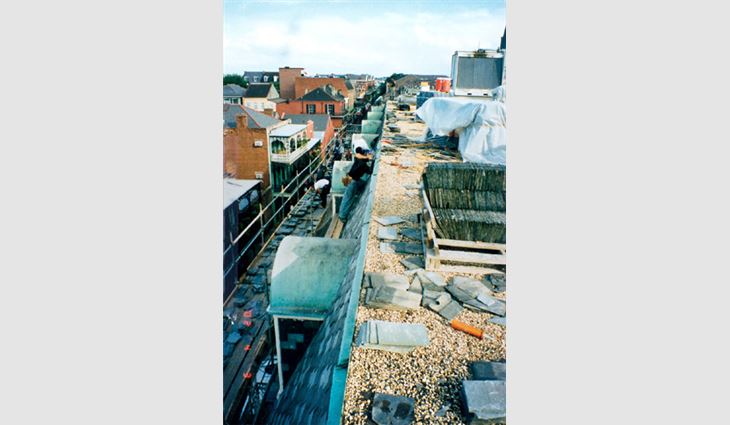 Photo courtesy of Roof Technologies Inc., Harvey, La.
Photo courtesy of Roof Technologies Inc., Harvey, La. 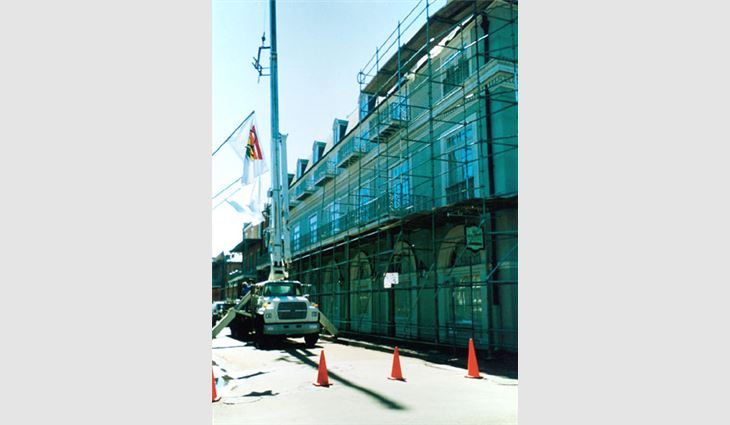 Photo courtesy of Roof Technologies Inc., Harvey, La.
Photo courtesy of Roof Technologies Inc., Harvey, La.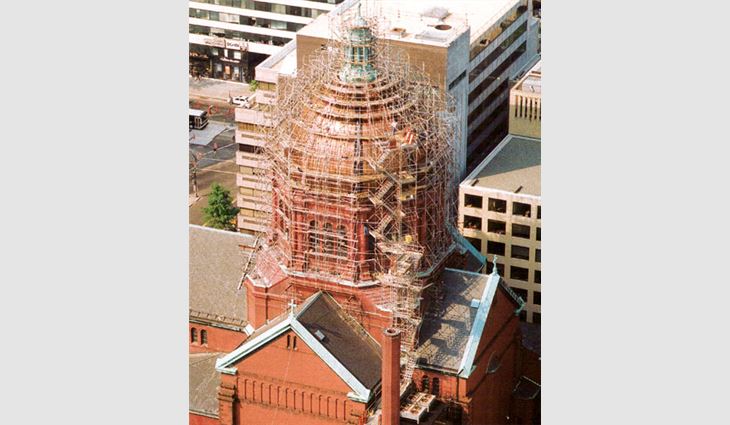 Photo courtesy of James Myers Co. Inc., Beltsville, Md.
Photo courtesy of James Myers Co. Inc., Beltsville, Md.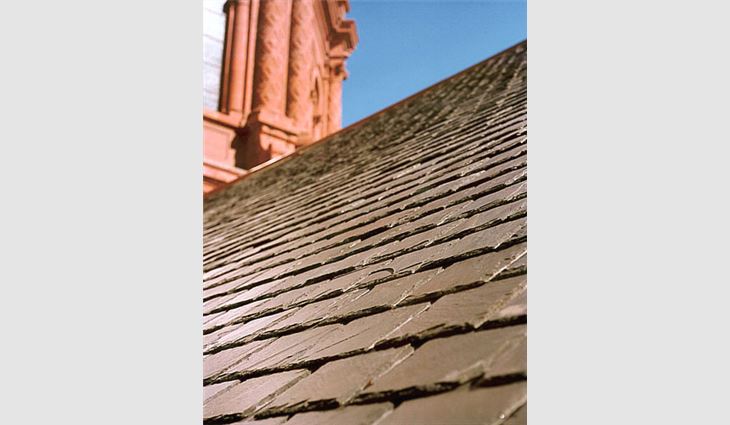 Photo courtesy of James Myers Co. Inc., Beltsville, Md.
Photo courtesy of James Myers Co. Inc., Beltsville, Md.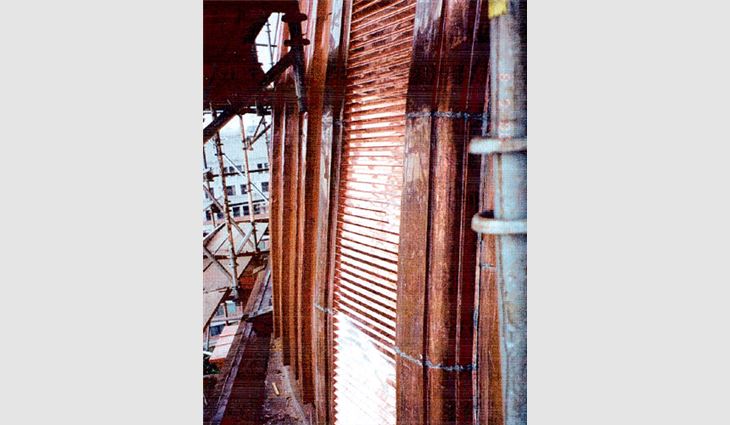 Photo courtesy of James Myers Co. Inc., Beltsville, Md.
Photo courtesy of James Myers Co. Inc., Beltsville, Md.Let's face facts. You probably never will be dressed in a Gucci tuxedo for a walk down a red carpet to accept an Oscar or be interviewed by the paparazzi. But did you know you have the opportunity to be recognized for your work?
NRCA annually bestows contractor members with its Gold Circle Awards during its convention. Winners of the 2003 Annual Gold Circle Awards include Chadwick Technology Property Ltd., Forestville, New South Wales, Australia; James Myers Co. Inc., Beltsville, Md.; and Roof Technologies Inc., Harvey, La.
Chadwick Technology won a Gold Circle Award for innovative solutions in new construction for the Adelaide Convention Centre extension, North Terrace, Adelaide, South Australia. The low-slope workmanship award was presented to James Myers Co. for the Cathedral of St. Matthew the Apostle, Washington, D.C. And Roof Technologies won an innovative solutions in reroofing award for the Bourbon Orleans Hotel, New Orleans. No steep-slope submissions were received.
Chadwick Technology
Chadwick Technology is the Tom Hanks of the Gold Circle Awards. The company won a Gold Circle Award in 2001 for the Expo Railway Station in Changi, Singapore; in 1999 for Exhibition Hall No. 1 of the Royal Agricultural Society in Homebush, Sydney, Australia; and in 1998 for the Kuala Lumpur International Air Terminal in Malaysia.
This year, NRCA recognized the company for roofing the expansion section of the Adelaide Convention Centre. The convention center sits on the River Torrens and is adjacent to downtown Adelaide. Adelaide, which is South Australia's capital and has a population of more than 1 million people, has become a popular convention location because of activities the area offers, such as golfing, surfing and exploring wine country.
Chadwick Technology installed an acoustic composite metal roof assembly, secondary structural components and the main external waterproofing cladding. When developing plans for the project, Chadwick Technology knew it had to be innovative to meet several requirements, including structural performance, acoustics, condensation control, aesthetics and complex geometry. The company began work in early February 2000 and finished in September 2001.
Meeting requirements
The convention center features a barrel-vault design, but the roof's leading edge is circular with variable radii. These different shapes created complex geometry for the box gutter system and roof edge profile, as well as double curvature.
To ease the installation and design processes, Chadwick Technology developed computer-aided drafting (CAD) spreadsheet technology. The software translated the building's information to computer-aided manufacturing programs, allowing the profiling of raw materials to be created to provide the correct shapes at the intersections of the individual components.
"Fifteen years ago, such a complex arrangement would not have been possible because of the lack of appropriate design capability and software," says Bill Mansell, managing director of Chadwick Technology.
In addition to unique geometry concerns, architects established minimum deflection criteria and live load and wind load requirements. Acoustics also had to be considered because the convention center is near an Adelaide International Airport flight path. A sound transmission loss performance level, therefore, was established. In addition, because the center is used for meetings, performances, conventions and other events, the composite roof assembly and ceiling had to include reverberation control to help improve interior listening acoustics.
Creating an attractive roof assembly that meets all these requirements was difficult.
"The architect had many standard roof deck profiles available for selection, [but] they did not suit his aesthetic requirements and were regarded as industrial," Mansell says.
Installation
The roof assembly, which is 172,228 square feet (16,000 m²), is supported by back-to-back C25024 BHP Purlins spaced at 47 inches (1200 mm) on center. To support mechanical and electrical loads, 0.12-inch (3-mm) tabs were placed between each purlin. The gaps caused by the tabs were filled with low-density compressible foam to stop sound flanking paths.
A Chadeck structural deck was installed directly to the purlins' upturned flanges. The deck, which is 19.7 inches (500 mm) high, has a 23.6-inch (600-mm) flat base pan. To provide acoustic performance, the base pan is perforated. Rockwool insulation was placed in the deck's base pan. The insulation, which is 2 inches (50 mm) thick, is faced with black fiberglass and encapsulated in thin polythene.
Next, 0.5-inch (13-mm) plasterboard was screwed to the deck's top flange. Two layers of fiberglass insulation then were laid in place to improve acoustic and thermal performances. The first layer is 3 inches (75 mm) thick and features an anti-glare foil on one side, and the second layer is 4.3 inches (110 mm) thick. A cement board was added to the purlins' top flanges.
Low-density foam was adhered to the cement board's top face at nominal 23.6-inch (600-mm) centers. Finally, Chadclad 240 roof panels were screwed to the deck's top flange. The button-punched roof panels, which were secured with galvanized steel clips, interlock each other. Because some roof panels are about 100 feet (30 m) long, Chadwick Technology designed spreader bars to lift them into position.
Because of oil-canning concerns (an aesthetic problem related to distortions in metal's flatness), testing was performed on Chadclad 240 roof panels and modifications were made to Chadwick Technology's roll-forming equipment to reduce the roof panels' pan width and avoid roof panel stress distortion. Roll-forming equipment, which produced about 10 miles (16 km) of roof panels, was established in an on-site factory.
Roof Technologies
If you've had the pleasure of strolling down Bourbon Street in the heart of New Orleans' French Quarter, you can appreciate the masses of people who flood the street and make it difficult to move from one jazz club to another. Imagine trying to set up scaffolding, transport equipment and materials, and complete a major reroofing project under such conditions.
Protecting Bourbon Street's tourists and maneuvering equipment and materials in a tight area were some of the challenges Roof Technologies overcame when reroofing the Bourbon Orleans Hotel. Because of the building's historical significance, the company also was required to consult the Vieux Carré Commission, which preserves the quaint, distinctive character of the French Quarter.
Similar to many buildings in the French Quarter, the Bourbon Orleans Hotel is rich in history. The building originally housed the prestigious Orleans Ballroom, which in the 1800s hosted many of the Crescent City's most elegant affairs, including grand balls for French nobleman Marquis de Lafayette, who is known for helping the United States win its independence from Great Britain. From the late 1800s until the early 1960s, the Orleans Ballroom belonged to The Sisters of the Holy Family, the second order of African-American nuns established in the United States.
In 1964, the property was bought by a New Orleans developer and the Bourbon Orleans Hotel was built around the Orleans Ballroom, which now houses the hotel's lobby, café and kitchens. Two adjacent buildings also are part of the hotel—a red-brick building built in the late 1800s that features meeting rooms and guest rooms, and a small cottage that includes administrative offices.
On Jan. 23, 2000, a hailstorm ripped through the greater New Orleans area causing nearly $500 million damage. Unfortunately, the Bourbon Orleans Hotel's roof systems had been neglected for several years and the hailstorm caused tremendous damage. In September 2001, Roof Technologies was asked to help the hotel's insurance adjuster determine the extent of damage to the roof systems. At that point, Bill Luebbert, president of Roof Technologies, realized the roof systems were beyond repair.
"Hailstones penetrated the slate and mansard roof systems," Luebbert says. "Holes the size of half dollars were found in some slate pieces."
Le projet
Roof Technologies was contracted to replace about 250 squares (2250 m²) of low-slope roof systems and 275 squares (2475 m²) of steep-slope roof systems. Because steep-slope roof systems could be seen from the street, they required review by the Vieux Carré Commission. The commission determined these roof areas should be reroofed using traditional slate.
Major planning was required because of the tight staging area around the hotel and safety requirements for roofing workers and tourists. In addition, the hotel would remain operational during roofing work, and hotel representatives demanded work be completed by the start of New Orleans' famous Jazz Fest, which was scheduled for the last weekend in April 2002.
Two crews totaling 20 men started work Feb. 4, 2002. Setting up scaffolding in the hotel's courtyard presented the first challenge to crew members. Because there was no direct access to the courtyard, all scaffolding had to be carried through the hotel and assembled in the courtyard.
While scaffolding was erected, crew members began work on the red-brick building and cottage. Before removal of existing asbestos-containing shingles, roofing workers performed air monitoring to determine permissible exposure limits (PEL). Because PEL levels were nonexistent, workers were not required to wear personal protective equipment. Once asbestos-containing shingles were removed, roofing workers discovered extreme damage to the wood roof decks. The decks had deteriorated because of weather conditions and Formosan termites, the most destructive termites in the southern United States.
The decks were repaired with 5/8-inch- (16-mm-) thick treated plywood. Then, 1,400 square feet (130 m²) of dark gray Re-Con Building Products Inc. Firefree® slate was installed on the red-brick building's roof system, and 3,000 square feet (279 m²) of slate were installed on the cottage's roof system. In addition, 3,000 square feet (279 m²) of the red-brick building's roof system were refelted and reslated.
A major concern during reroofing work on the former ballroom area was repairing the hotel's cooling tower, which was leaking and slowly destroying its roof system. After an inspection by a heating, ventilating and air-conditioning company, it was determined the cooling tower needed to be completely overhauled and repiped.
After the cooling tower was repaired, roofing workers tore off the low-slope area's existing four-ply, gravel-covered built-up roof system and installed a vented base sheet and two-ply APP-modified bitumen roof system manufactured by Firestone Building Products Co. A crane was used to remove debris and raise new materials to the roof. While the crane was in use, Roof Technologies had to close streets around the hotel and was required to hire an off-duty police officer to redirect traffic. Streets were closed for three hours to four hours during early morning. Firefree slate was installed on the steep-slope areas of the hotel's mansard roof system.
By Feb. 25, 2002, crew members completed work on the courtyard's interior mansard roof system and began erecting scaffolding on the hotel's exterior to work on the mansard roof system's outer steep-slope area. The scaffolding not only provided access to the roof systems and protection for roofing workers, it also protected pedestrians on Bourbon Street.
In addition to roofing work, sheet-metal work was required. The crew replaced internal gutters and downspouts that connected to the French Quarter's subsurface drainage system. All sheet metal was fabricated in Roof Technologies' sheet-metal shop.
Fantastique!
Considering the amount of work that went into the project, it's amazing the Bourbon Orleans Hotel was completed by April 25, 2002, in time for Jazz Fest, under budget and without any safety issues. And it's appropriate Roof Technologies was honored with a 2003 Gold Circle Award for innovative solutions in reroofing.
"We are sincerely humbled to be recognized by our peers," Luebbert declares. "Roof Technologies' ability to perform under stringent demands and time restraints demonstrates the ability of our industry as a whole. Ours is an industry that is strong, viable and able to meet any conditions established by our clients."
James Myers Co.
The Cathedral of St. Matthew the Apostle honors the patron saint of civil servants. The cathedral, which is the seat of the Archbishop of Washington, D.C., plays a major role in the U.S. capital. For example, former President John F. Kennedy's funeral mass was held at the cathedral on Nov. 25, 1963, and each fall, the cathedral holds its Red Mass, which seeks guidance from the Holy Spirit for members of the legal profession. Red Mass is attended by Supreme Court justices, members of Congress and diplomatic corps, and the president and his Cabinet.
A cathedral that maintains such prestige within the U.S. government only could be reroofed by a company that understands what it is like to work on a prominent building. James Myers Co. is a company experienced with other notable Washington landmarks, including being the lead roofing contracting company for the NRCA Pentagon Project, the association's volunteer effort that restored the Pentagon's roof system after the Sept. 11, 2001, attack.
Since the cathedral's construction in 1893, only minor roof repairs had been performed. By 2000, the roof systems' slate, which had outlasted its 70-year life expectancy by more than 30 years, was worn, brittle and cracked. The dome's copper was pitted and eroded, and the building's wood substrates had rotted. James Myers Co. knew it had an elaborate job ahead.
Because of the complex work required, James Myers Co. decided to reroof the cathedral in two phases—the dome followed by the slate roof systems. During the phases, plans had to be coordinated with cathedral officials because the cathedral remained open. In addition, the cathedral's valuable interior required the building to be watertight at all times.
Phase I
In January 2000, Phase I began on the dome and included the removal and replication of a vintage, radius-combination batten and standing-seam copper roof system; copper built-in gutter system; and copper ornamental hip details.
Before work began, a debris net was installed inside the cathedral below the dome's ceiling so falling materials would not damage the ornate interior. Then, a scaffolding system was engineered and erected by Safeway Scaffolding, Washington, D.C., around the dome's exterior, which is 190 feet (58 m) above ground level at its cupola.
"Conventional scaffolding is not designed to be constructed around a dome," states Richard Myers, project manager for James Myers Co. "Because the exterior was decorative and multiple levels of scaffolding were required, the scaffolding was a major project in itself."
Because the cathedral's original drawings had been lost during the 107 years since it was built, James Myers Co.'s 10- to 20-member crew took photographs of the cathedral's existing conditions and details, as well as documented its measurements and layout. These detailed layout sketches then were transferred into a CAD format. In addition, James Myers Co. worked with Washington, D.C.-based Oehrlein & Associates Architects, an architectural firm that specializes in historic preservation, to ensure the cathedral was restored to its original design.
During removal of the dome's copper, crew members discovered many original copper roof pans were fastened to dry-rotted wood battens and secured with corroded steel nails. The wood battens and steel fasteners were removed, and a layer of W.R. Grace & Co. self-adhering Ice & Water Shield® was placed over the existing tile and mortar substrate, which was in good condition. Testing was required to determine an appropriate fastener for installation on the unusual substrate. Pressure-treated wood battens then were installed with stainless-steel fasteners.
Revere Copper Products Inc. copper roof pans were fabricated by hand in the company's sheet-metal shop. Because the roof panel layout was unusual, both sides of each copper roof pan had to be stretched to fit the dome's radius profile in 5-foot (1.5-m) lengths. To do this, each roof pan required trimming and turning by hand.
"I considered each copper sheet ornamental. For the most part, the sheets were the same, but each sheet was a slightly different dimension," Myers reports.
At the dome's base, a built-in copper gutter held the cathedral's existing drains. The crew replaced the drains with bronze drains that feature clamping rings and strainers.
Before installation of the new gutter system, each drain leader was videotaped to see whether there were cracks or obstructions in the cathedral's existing cast-iron plumbing lines. Crew members were surprised to find the drain system in good condition; only drain bodies at the gutter level were required to be replaced. The drain bodies then were tied into the building's existing cast-iron plumbing lines. In addition, James Myers Co.'s sheet-metal shop replicated the dome's overflow drains and included them in the new gutter assembly.
Ornamental features, such as molding around the dome, balls and cornices, were repaired or removed from the building and replicated in James Myers Co.'s sheet-metal shop. In addition, the company was asked to gold leaf a metal cross located above the cathedral's main entrance.
Phase II
In late 2000, Phase II began. This phase included the replacement of the cathedral's main slate roof systems and lower copper roof systems. Repairs to cracked and crumbling masonry and stone components on the building's existing facade were completed by Washington, D.C.-based Watercraftsmen.
To complicate this phase's work, scaffolding around the dome, which partially was supported by the main slate and lower copper roof systems, had to remain in place so masons could repair the façade. James Myers Co. carefully coordinated roofing work with masonry work to ensure masons were not working above roofing workers, which could have caused safety issues.
As work began on the slate roof systems, James Myers Co.'s crew discovered a portion of the existing Buckingham slate roof system was installed directly on a concrete substrate using heavy-gauge steel nails. The crew fabricated a plywood substrate on which it installed the new Buckingham slate roof system with copper slating nails. In addition, some existing wood substrates under the copper roof systems were badly deteriorated and needed to be replaced.
The company also was asked to repair or replace the existing copper cornices. When crew members removed the cornices, they discovered the wood support framing system had rotted and wood outriggers were embedded in the cathedral's original masonry. Because crew members didn't know the state of the embedded wood, they couldn't duplicate the support framing system and were forced to design a new system with metal support angles and pressure-treated wood blocking.
Work on Phase II was completed in December 2001. More than 50,000 pounds (22680 kg) of Revere Copper Products copper and 15,000 square feet (1390 m²) of Buckingham slate products were used during the restoration.
Myers has great confidence in the work his crew performed on the Cathedral of St. Matthew the Apostle.
Myers declares: "Simply put, we put everything back the way it was but with today's technological improvements. The original roof system lasted more than 100 years. I'm certain our improvements and quality workmanship will make the new roof system last well into the 22nd century."
The honor
NRCA-contractor members cannot nominate themselves for Gold Circle Awards. Nominations must come from building owners, NRCA affiliate executives, manufacturers or design professionals. NRCA encourages these groups to continue to recognize contractor members for their outstanding work.
Winning a Gold Circle Award may not bring the glamour and glitz associated with Hollywood-type awards, but those who have won Gold Circle Awards can tell you being recognized by their peers for performing outstanding work is just as rewarding.
Kate Gawlik is associate editor of Professional Roofing magazine, and Christina Koch is associate editor of Professional Roofing magazine and NRCA's manager of public relations.
Nominate an NRCA-contractor member
Help roofing contractors be recognized by their peers during NRCA's 117th Annual Convention and Exhibit in San Diego Feb. 22-25, 2004, for their outstanding work.
NRCA-contractor members can win Gold Circle Awards for outstanding workmanship, innovative solutions, service to the community and service to the industry. To qualify for a 2004 award, roofing-related jobs, programs and services must have been completed between June 2001 and June 2003.
The deadline for entries is Sept. 8. For more information, contact Chrystine Hanus, NRCA's executive assistant, at (847) 299-9070, Ext. 7522, or chanus@nrca.net.
COMMENTS
Be the first to comment. Please log in to leave a comment.